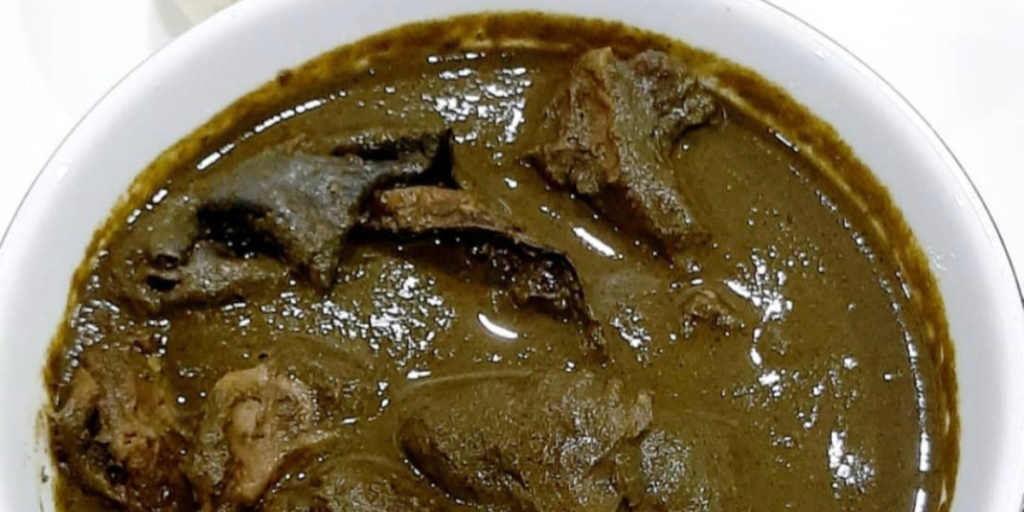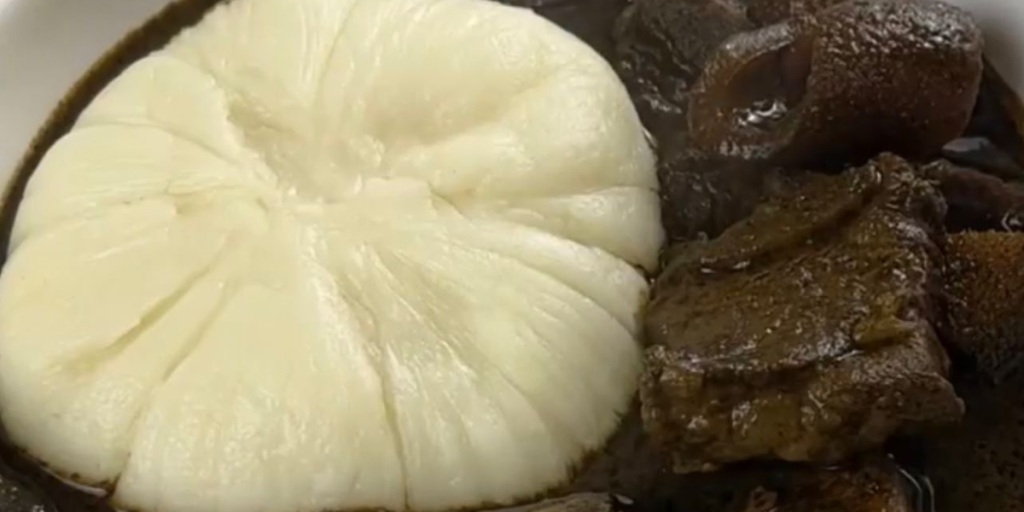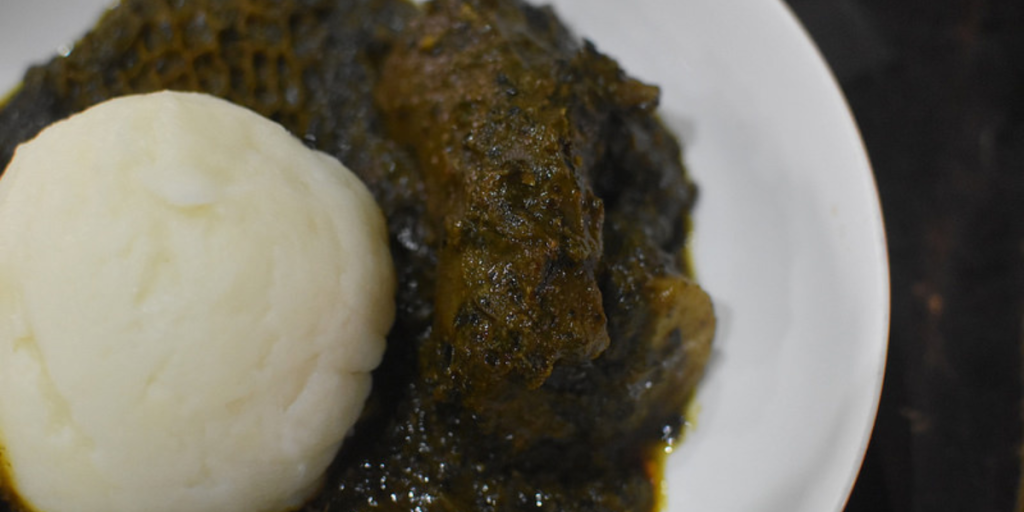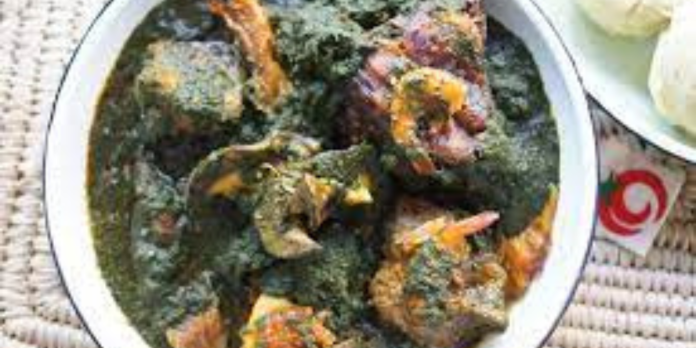Table of Contents
Igbo Black Soup, known as Ofe Oji or Oji Soup, is a cherished delicacy from the Igbo ethnic group of Nigeria. This soup is renowned for its unique blend of ingredients and its comforting, savory taste. Unlike many other Nigerian soups, Igbo Black Soup does not use palm oil, giving it a distinct light color and rich flavor profile. This guide will walk you through the process of making this delightful soup, from selecting ingredients to serving the final dish.
Understanding Igbo Black Soup

Historical Background
Igbo Black Soup, traditionally known as Ofe Oji, has deep roots in the culinary traditions of the Igbo people. The soup is often referred to as “white soup” due to its light color, a distinguishing feature that sets it apart from other Nigerian soups. Ofe Oji is commonly served during special occasions such as weddings, festivals, and family gatherings. It is a symbol of hospitality and celebration, reflecting the rich cultural heritage of the Igbo community.
The origins of Igbo Black Soup can be traced back to ancient times when the Igbo people utilized locally available ingredients to create nourishing and flavorful dishes. The use of yam or cocoyam as a thickening agent and the absence of palm oil highlight the ingenuity of Igbo culinary practices. Today, Igbo Black Soup remains a beloved dish, enjoyed by both locals and those exploring Nigerian cuisine.
What are the ingredients in black soup in Ondo? 2024
Key Characteristics
Igbo Black Soup is characterized by its light color and thick, creamy texture. Unlike many other Nigerian soups that rely on palm oil for color and flavor, Igbo Black Soup uses yam or cocoyam as the primary thickening agent. This gives the soup a smooth, rich consistency without the heaviness of palm oil.
The soup is also known for its unique flavor profile, which comes from a blend of spices and seasonings such as uziza seeds, crayfish, and ogiri Igbo (fermented locust beans). These ingredients contribute to the soup’s distinctive taste, making it a favorite among those who appreciate bold and savory flavors.
Ondo Black Soup 2024 Best Guide
Essential Ingredients
Primary Ingredients
To make authentic Igbo Black Soup, you will need the following primary ingredients:
- Yam or Cocoyam: Yam or cocoyam serves as the thickening agent for the soup. The tubers are peeled, cooked, and then blended or pounded into a smooth paste. This paste is gradually added to the soup to achieve the desired consistency.
- Catfish or Goat Meat: Catfish is a popular choice for Igbo Black Soup due to its rich flavor and tender texture. Goat meat is another common option, providing a hearty and robust taste. Both proteins can be used together or separately, depending on personal preference.
- Uziza Seeds: Uziza seeds add a peppery, slightly bitter flavor to the soup. They are typically toasted and ground before being added to the soup base.
- Crayfish: Ground crayfish imparts a subtle seafood taste, enhancing the overall flavor of the soup.
- Ogiri Igbo: Ogiri Igbo is a fermented seasoning made from locust beans. It adds depth and complexity to the soup, contributing to its unique taste.
- Uyayak Pod (Aidan Fruit): Uyayak pod, also known as Aidan fruit, is an optional ingredient used to add a distinctive flavor to the soup. It is typically added in small quantities.
What Are The Benefits of Black soup best 2024
Seasonings and Spices
In addition to the primary ingredients, the following seasonings and spices are essential for making Igbo Black Soup:
- Onions: Chopped onions are sautéed to create a flavorful base for the soup.
- Fresh Peppers: Fresh peppers, such as habanero or Scotch bonnet, add heat and flavor to the soup.
- Seasoning Cubes: Seasoning cubes (like Maggi or Knorr) are used to enhance the overall taste of the soup.
- Salt: Salt is added to taste, balancing the flavors of the soup.
- Fresh Utazi Leaves: Fresh utazi leaves add a slightly bitter taste and are typically added towards the end of the cooking process.
Selecting Fresh Ingredients
When making Igbo Black Soup, it is important to select fresh and high-quality ingredients. Here are some tips for choosing the best ingredients:
- Yam or Cocoyam: Choose firm and fresh tubers with no signs of spoilage or mold. The skin should be smooth and free from blemishes.
- Catfish or Goat Meat: Purchase fresh fish or meat from a reputable source. Ensure that the fish is cleaned and gutted, and the meat is cut into bite-sized pieces.
- Uziza Seeds: Look for whole uziza seeds that are free from dirt and debris. Freshly ground seeds provide the best flavor.
- Crayfish: Use ground crayfish that is free from sand and impurities. Freshly ground crayfish has a stronger flavor compared to pre-packaged varieties.
- Ogiri Igbo: Ensure that the ogiri Igbo is fresh and free from any foul odor. It should have a pungent aroma characteristic of fermented locust beans.
Preparing the Ingredients
Yam or Cocoyam
- Peeling and Cutting Yam or Cocoyam:
- Using a sharp knife, peel the yam or cocoyam tubers to remove the skin.
- Cut the peeled tubers into smaller chunks to facilitate even cooking.
- Cooking Yam or Cocoyam:
- Place the yam or cocoyam chunks in a pot and add enough water to cover them.
- Bring the water to a boil and cook until the tubers are tender and can be easily pierced with a fork, usually about 15-20 minutes.
- Drain the cooked tubers and allow them to cool slightly.
- Blending or Pounding Yam or Cocoyam:
- Transfer the cooled tubers to a blender or food processor and blend until smooth.
- If using traditional methods, pound the tubers in a mortar and pestle until smooth and free from lumps.
- The resulting paste should be thick and creamy, ready to be added to the soup.
Meat and Fish
- Cleaning and Prepping Catfish or Goat Meat:
- For catfish, clean the fish thoroughly, removing any scales, gut, and gills. Cut the fish into steaks or fillets.
- For goat meat, rinse the meat under cold running water to remove any blood or impurities. Cut the meat into bite-sized pieces.
- Marinating Techniques:
- To enhance the flavor of the meat or fish, marinate it with a mixture of seasoning cubes, salt, and fresh peppers.
- Allow the meat or fish to marinate for at least 30 minutes to absorb the flavors.
Black Soup Recipe Best of 2024
Seasonings and Spices
- Toasting and Grinding Uziza Seeds:
- Heat a dry skillet over medium heat and add the uziza seeds.
- Toast the seeds for a few minutes until fragrant, stirring constantly to prevent burning.
- Remove the seeds from the heat and allow them to cool before grinding them into a fine powder using a spice grinder or mortar and pestle.
- Preparing Crayfish and Ogiri Igbo:
- If using whole crayfish, grind them into a fine powder using a spice grinder or mortar and pestle.
- For ogiri Igbo, break it into small pieces to facilitate even distribution in the soup.
Cooking the Soup Base
Starting the Soup Base
- Creating the Soup Base:
- In a large pot, heat a small amount of oil over medium heat. Add chopped onions and sauté until golden brown and fragrant.
- Add the ground uziza seeds and ground crayfish to the pot, stirring continuously to release their flavors.
- Incorporate the prepared yam or cocoyam paste gradually, stirring to ensure it dissolves smoothly into the soup base.
Incorporating Proteins
- Adding Catfish or Goat Meat:
- Add the marinated catfish or goat meat to the pot, ensuring they are evenly distributed in the soup.
- Stir gently to combine the proteins with the soup base.
- Cooking Times and Techniques:
- Bring the soup to a gentle boil, then reduce the heat to low and let it simmer.
- Cook the soup for about 30-45 minutes, stirring occasionally to prevent sticking and burning.
- Ensure the meat is tender and the fish is cooked through before proceeding to the next step.
Achieving the Right Consistency
- Thickening the Soup:
- As the soup simmers, the yam or cocoyam paste will thicken it. Stir frequently to prevent lumps and ensure an even consistency.
- If the soup is too thick, add water gradually until you achieve the desired consistency. For a thicker soup, add less water.
- Simmering to Meld Flavors:
- Allow the soup to simmer on low heat for an additional 20-30 minutes to let the flavors meld together.
- Stir occasionally and adjust the seasoning as necessary, adding salt and seasoning cubes to taste.
Combining and Cooking

Blending Flavors
- Adding Crayfish, Uziza Seeds, and Ogiri Igbo:
- Add the ground crayfish, toasted and ground uziza seeds, and pieces of ogiri Igbo to the soup.
- Stir well to ensure the ingredients are evenly distributed and the flavors are well incorporated.
- Simmering to Meld Flavors:
- Allow the soup to simmer for another 10-15 minutes, stirring occasionally to prevent sticking.
- Taste the soup and adjust the seasoning if necessary, adding more salt or seasoning cubes as needed.
Final Touches
- Adding Fresh Utazi Leaves:
- Wash and chop the fresh utazi leaves.
- Add the chopped utazi leaves to the soup and stir gently to incorporate them.
- Let the soup simmer for an additional 5-10 minutes to allow the leaves to cook and release their flavors.
- Adjusting Seasonings:
- Taste the soup one final time and make any necessary adjustments to the seasoning.
- Ensure the soup has a balanced flavor with a hint of pepperiness from the uziza seeds and a slight bitterness from the utazi leaves.
Cooking Times and Techniques
- Monitoring Cooking Times:
- Keep a close eye on the soup as it simmers to prevent overcooking the meat and fish.
- Use a fork or a taste test to check the tenderness of the meat and the doneness of the fish.
- Maintaining Texture and Flavor:
- Stir the soup gently to avoid breaking up the fish pieces.
- Ensure the yam or cocoyam paste is well incorporated and the soup has a smooth, creamy texture.
Serving Igbo Black Soup
Traditional Serving Suggestions
- With Pounded Yam:
- Pounded yam is a traditional accompaniment to Igbo Black Soup. To prepare pounded yam, boil yam chunks until tender, then pound or blend them until smooth and stretchy.
- Serve a portion of pounded yam with a generous bowl of Igbo Black Soup for a hearty and satisfying meal.
- With Fufu or Eba:
- Fufu and eba are other common side dishes for Igbo Black Soup. Fufu is made from fermented cassava, while eba is made from garri (cassava flour).
- Prepare fufu or eba according to package instructions and serve alongside the soup.
Complementary Side Dishes
- Yam Pottage:
- Yam pottage, also known as Asaro, is a delicious side dish that pairs well with Igbo Black Soup. It is made by cooking yam chunks with palm oil, vegetables, and seasonings until soft and creamy.
- White Rice:
- White rice is another simple and versatile side dish that complements the rich flavors of Igbo Black Soup. Serve a portion of steamed white rice with the soup for a complete meal.
Garnishing and Plating
- Garnishing with Fresh Herbs:
- Garnish the soup with additional fresh utazi leaves or chopped parsley for a burst of color and flavor.
- Sprinkle a pinch of ground crayfish or uziza seeds on top for added texture and taste.
- Plating Techniques:
- Use a large, shallow bowl to serve the soup, allowing the meat and fish pieces to be prominently displayed.
- Arrange the pounded yam, fufu, or eba on a separate plate or in smaller bowls for a visually appealing presentation.
Exploring Variations
Regional Variations
- Nsukka Variation:
- In the Nsukka region of Igbo land, Ofe Nsala is often made with a combination of catfish and stockfish. Stockfish adds a distinct flavor and chewy texture to the soup.
- Another variation includes the use of yellow pepper for a different type of heat and flavor profile.
- Anambra Variation:
- In Anambra state, the use of cocoyam as a thickener is more common than yam. This gives the soup a slightly different texture and taste.
- Anambra cooks also often add a variety of leafy greens such as spinach or fluted pumpkin leaves for additional nutrition and flavor.
Vegetarian and Alternative Versions
- Vegetarian Igbo Black Soup:
- For a vegetarian version, replace the catfish or goat meat with mushrooms or tofu. These ingredients provide a meaty texture and absorb the flavors of the soup well.
- Use vegetable broth instead of meat broth to maintain the vegetarian nature of the dish.
- Using Different Proteins:
- Experiment with other proteins such as chicken, turkey, or beef. Each protein will add a unique flavor and texture to the soup.
- Ensure that the chosen protein is cooked until tender and well-integrated into the soup base.
Adjusting for Dietary Preferences
- Reducing Spiciness:
- To reduce the spiciness of the soup, use fewer fresh peppers and remove the seeds before adding them to the soup.
- You can also balance the heat by adding more yam or cocoyam paste, which will mellow out the spiciness.
- Substitutions for Common Allergens:
- If you are allergic to shellfish, omit the crayfish and use a seafood-free seasoning instead.
- For those with gluten sensitivities, ensure that the seasoning cubes used are gluten-free, and check the ingredients of any processed seasonings.
Frequently Asked Questions

What is Igbo Black Soup? Igbo Black Soup, also known as Ofe Oji, is a traditional Nigerian soup from the Igbo ethnic group. It is known for its light color, thick consistency, and rich, savory flavor. The soup is made using yam or cocoyam as a thickening agent and is flavored with spices such as uziza seeds, crayfish, and ogiri Igbo. Commonly used proteins include catfish and goat meat.
Can I substitute yam with cocoyam? Yes, cocoyam can be used as an alternative thickening agent in Igbo Black Soup. While yam provides a starchy and smooth consistency, cocoyam adds a slightly different texture and flavor. Both options are traditional and can be used based on availability and personal preference.
How do I reduce the spiciness of the soup? To reduce the spiciness of Igbo Black Soup, use fewer fresh peppers and remove the seeds before adding them to the soup. You can also balance the heat by adding more yam or cocoyam paste, which will mellow out the spiciness. Additionally, using milder peppers like bell peppers instead of habanero or Scotch bonnet can help reduce the overall heat.
What are common mistakes to avoid?
- Overcooking the Meat: Overcooked meat can become tough and chewy. Ensure that the meat is cooked just until tender.
- Not Properly Blending the Yam or Cocoyam: Lumpy paste can result in an uneven soup texture. Blend or pound the yam or cocoyam until completely smooth.
- Using Too Much or Too Little Seasoning: Taste the soup frequently and adjust the seasoning as needed. Underseasoned soup can be bland, while overseasoned soup can be too salty or overpowering.
How long can I store Igbo Black Soup? Igbo Black Soup can be stored in an airtight container in the refrigerator for up to 5 days. Ensure that the soup is completely cooled before storing to prevent bacterial growth. Reheat the soup gently on the stove or in the microwave before serving.
Can Igbo Black Soup be frozen? Yes, Igbo Black Soup can be frozen for up to 3 months. To freeze, allow the soup to cool completely, then transfer it to freezer-safe containers or bags. Label the containers with the date and contents for easy identification. Thaw the soup in the refrigerator overnight before reheating.
What side dishes go well with Igbo Black Soup? Traditional side dishes that pair well with Igbo Black Soup include pounded yam, fufu, and eba. These starchy accompaniments help balance the flavors of the soup and provide a satisfying meal. Additionally, yam pottage and steamed white rice are excellent options to serve alongside the soup.
Conclusion
Igbo Black Soup is a rich and flavorful dish that brings a taste of Nigerian culture into your kitchen. By following this detailed guide, you can create an authentic and delicious Igbo Black Soup that will impress your family and friends. Enjoy the process and experiment with different ingredients to make the recipe your own.
Appendices
Glossary of Terms
- Uziza Seeds: A type of peppery seed used in Nigerian cooking, known for its distinct flavor.
- Ogiri Igbo: A fermented seasoning made from locust beans, adding depth and complexity to the soup.
- Uyayak Pod (Aidan Fruit): Aidan fruit used for flavoring soups, known for its unique taste.
Nutritional Information
Igbo Black Soup is a nutritious dish rich in protein, vitamins, and minerals. The yam or cocoyam provides carbohydrates, while the meat or fish adds protein. The soup is also a good source of dietary fiber and essential nutrients from the various spices and seasonings used.
Resource List
- Recommended Stores and Markets:
- Visit local African or international grocery stores for authentic ingredients.
- Check online retailers for specialty items like uziza seeds and ogiri Igbo.
- Websites and Cookbooks:
- Explore websites dedicated to Nigerian cuisine for more traditional recipes and cooking tips.
- Look for cookbooks that focus on West African cooking for a broader understanding of the culinary traditions.






















How can you call Igbo black soup “ofe nsala” my friend? When I looked up your name I knew it must have been a typo.
Black soup is called “Ofe Oji” not “Nsala soup or Ofe Nsala.” Ofe Nsala is white soup and not black soup.
We call Igbos call it Ofe Oji not black soup…use only our native names only. I revisited this to make just to make the correction sir.
I hope you will correct that sir.
Have a great day.
was an error bro will work on it